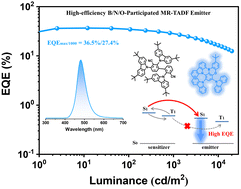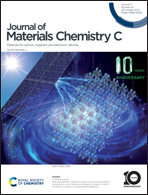B/N/O-participated multi-resonance TADF emitters by a simple peripheral decoration strategy enable high-efficiency electroluminescence with EQEs up to 36.5%†
Abstract
Multi-resonance thermally activated delayed fluorescence (MR-TADF) emitters featuring intrinsic narrowband emission are highly attractive for organic light-emitting electroluminescence device with g diodes (OLEDs) with high color purity. In this work, two new MR-TADF emitters, namely DCzBNO and TCzBNO, were designed and prepared, which featured the MR effect induced by the opposite boron and nitrogen/oxygen atom. By virtue of the good photophysical properties including the small singlet–triplet splitting and high photoluminescence quantum yield, DCzBNO achieved a maximum external quantum efficiency (EQE) of 21.6% with Commission Internationale de l’Eclairage (CIE) coordinates of (0.13, 0.28) in electroluminescence devices, which could be enhanced to 31.7% in the TADF-sensitized device using a TADF emitter as the sensitizer. Impressively, the TCzBNO-based sensitized device delivered an excellent maximum EQE of 36.5%, with suppressed efficiency roll-off at the brightness of 1000 cd m−2.

- This article is part of the themed collection: 2023 Journal of Materials Chemistry C HOT Papers


 Please wait while we load your content...
Please wait while we load your content...